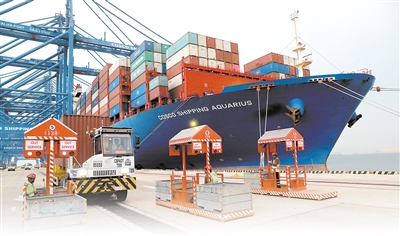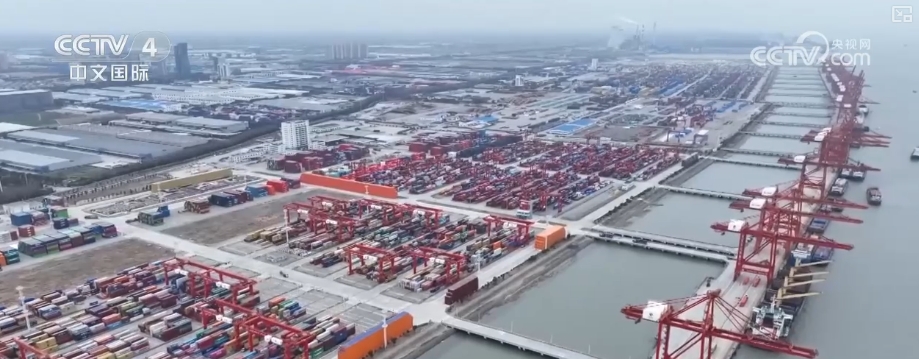Construction Of External Communication System Under The Background Of "Belt And Road"
Construction Of External Communication System Under The Background Of "Belt And Road"
After the "Belt and Road" initiative was proposed, new requirements were put forward for my country's international communication capabilities. With the significant improvement of the country's comprehensive national strength and international status, China's external communication has shown an upward trend. my country is more proactive in shaping its international image and doing a good job in external communication. future
After the "Belt and Road" initiative was proposed, new requirements were put forward for my country's international communication capabilities. With the significant improvement of the country's comprehensive national strength and international status, China's external communication has shown an upward trend. my country is more proactive in shaping its international image and doing a good job in external communication. In the future, we should enhance the Internet communication power and the guidance of international public opinion through innovation in international communication concepts, methods and mechanisms, and strive to enhance our country's influence in the international public opinion field.
On August 19, 2013, General Secretary Xi Jinping pointed out at the National Propaganda and Ideological Work Conference: We must do a good job in external publicity, innovate external publicity methods, and strive to create new concepts, new categories and new expressions that integrate China and foreign countries, tell Chinese stories well, and spread Chinese voice well. With the significant improvement of the country's comprehensive national strength and international status, the construction of my country's external communication system has shown an upward trend. People are not only paying more attention to how the world views China, but also paying more attention to the many impacts that changes in the international community will bring to China. Since the "Belt and Road" initiative was proposed by our leaders in 2013, this historical heritage of extraordinary significance to China and the world has been rejuvenated with new vitality.
In May 2015, General Secretary Xi Jinping put forward the "new requirements of the times" for the overall foreign communication on the occasion of the 30th anniversary of the founding of the People's Daily Overseas Edition: "The task is to spread the excellent Chinese culture and promote and introduce China's development and changes; to grasp the way overseas readers are willing to accept, and master easy-to-understand language as a means; to tell good Chinese stories and spread good Chinese voice as a goal." On December 31, 2016, when China International Television was broadcast, General Secretary Xi pointed out: "The world today is an open world, and China today is an open China." "The relationship between China and the world is undergoing historic changes. China needs to better understand the world, and the world needs to better understand China."
In recent years, domestic and foreign public opinion has conducted long-term observations and discussions on issues such as the intention, policy means, prospects, promotion process, and impact of the "Belt and Road" initiative. External communication under the background of the "Belt and Road" is the need for the "Belt and Road" initiative to expand its own global communication needs and my country's need to enhance its international discourse power. With the joint efforts of the international community and all sectors of society, we have developed in depth to the "five links".
1. Distribution of hot topics in international news
In recent years, international relations, political elections, terrorism, global economy, social movements, etc. have become hot topics. The international situation changed in 2016, from Brexit, the wave of refugees in Europe, to frequent terrorist attacks, Turkey's military coup, Brazil's Rio Olympics, Japan's nuclear radiation, North Korea's nuclear incident, South Korea's "comrades interfere in politics" and the US election. Affected by the "Belt and Road", multilateral relations and high-level dynamics have also attracted public attention (see Figure 1). According to statistics, the proportion of international hot spots in China is higher than that in my country's national foreign-related news. Various international forums hosted by my country and visits by senior leaders often become hot topics in media reports, while Western media are very concerned about topics in the fields of society, culture and human rights, and have relatively many comments.
Under the new era conditions, new Internet media has become an important channel for international communication. In terms of international public opinion, Chinese netizens have more participation. For example, on January 22, the article "Emperor Bar set out to fight for FB, AIA has something to say", affirmed the rationality and creativity of young netizens from a certain perspective.
In 2016, in the joint construction and cooperation of the "Belt and Road", my country's trade cooperation with countries along the route achieved phased results, and was also included in the main goals, tasks and major measures during the "13th Five-Year Plan" period. In December 2016, the 30th meeting of the Central Leading Group for Comprehensively Deepening Reforms pointed out that soft power is an important booster for the construction of the "Belt and Road". At the same time, an article pointed out that "interconnection between people and people" is the key and difficulty of the "five connections".
2. my country's external communication capabilities are improved
As of the end of February 2017, in terms of external reports, the total number of Chinese media reports on the "Belt and Road" in English was about 4,535, and the number of related reports on overseas media was 7,300. Unlike Chinese media communications news, overseas media reports on China's "Belt and Road" construction are more comprehensive, with diverse attention angles, and mainly observation, analysis, and commentary articles when reporting, and the content is highly readable. Overseas media have mostly reported on the construction of the "Belt and Road" in my country, and have more cultural and social observations, which is related to Western media's attention to the dividends of the "Belt and Road" and their awareness of international competition.
With the background of the "Belt and Road", my country has held a large number of home meetings in recent years to give full play to the characteristics of home communication. For example, the full media coverage of the G20 Summit integrates text, pictures, video, audio, H5 and other forms, expanding from diplomacy, economy, trade, finance, culture and other fields to tourism and benefiting the people. At the same time, the report is connected internally and externally, which improves the reporting effect and allows the world to better understand China.
At the same time, under the general background of the implementation of the "Belt and Road" initiative, international personnel exchanges, economic and trade exchanges, cultural exchanges and outbound tourism have become more frequent. The National Tourism Administration's "2016 Annual Survey Report on the Civilized Image of Chinese Outbound Tourists" pointed out that the media plays an important role in influencing the people's evaluation of Chinese tourists. In countries or regions where negative media reports are mainly reported, the public's evaluation of the quality of Chinese outbound tourists is also relatively low. For example, the incident of Chinese tourists taking away Japanese toilet lids and Thai shrimp shoveling incidents have been proven to be different from the facts. On the one hand, it is due to the lack of national self-confidence, and on the other hand, it is the impact of many negative media reports. However, overall, most foreign media reports in 2016 were more objective, such as the French European Times reported that "The Return of the National Day, Chinese tourists turn around overseas in a gorgeous way." The Washington Post said that China's outbound travel market is becoming increasingly popular, and some tourists are not civilized enough, but among the more than 100 million outbound tourists in China, the vast majority are not like this.
According to statistics, the peak of reporting on the "Belt and Road" by overseas media is consistent with the peak of China's external communications on the "Belt and Road", and the topic setting effect is obvious. In addition, Chinese media reports on the "Belt and Road" dominate the issue of diplomatic (29%) and economic (28%), accounting for more than half of the total. The distribution of overseas media reports on the "Belt and Road" is relatively balanced, and it also includes comprehensive, cultural and social categories. In terms of regional aspects, domestic media mentioned hot cities, mainly including Beijing (260 articles), Hangzhou (137 articles), Hong Kong (103 articles), Shanghai (91 articles), Xi'an (80 articles), etc. The Hangzhou G20 Summit is of great significance to improving the urban external communication pattern and promoting urban internationalization. In addition, in conjunction with President Xi Jinping's trip to the Middle East in 2016, Cairo, the capital of Egypt (58 articles) and Tehran, the capital of Iran (44 articles) are among the top foreign cities, which shows the important position of Asia and Africa.
3. Belt and Road Initiative Expands Media Cooperation Opportunities
Overall, the proposal and construction implementation of the "Belt and Road" initiative has provided more stages and opportunities for the growth of my country's media, and the open mind is more confident and positive. In July 2016, the 2016 Belt and Road Media Cooperation Forum was held in Beijing. President Xi Jinping sent a congratulatory letter and specifically pointed out that the media plays an irreplaceable and important role in information dissemination, enhancing mutual trust, and building consensus. "The friendship between countries lies in the blind date of the people", building a bridge between the people's hearts between different countries, regions, nations and religions, and establishing a good image of China, the media plays a crucial role in linking.
Looking back on 2016, cooperation between media has become normal. The 2016 "Belt and Road" Media Cooperation Forum, Asia-Europe Media Dialogue, and the first "Southern Silk Road Development Forum" have all built a platform framework for further pragmatic cooperation. In the past, the media has been committed to "going out" and reporting on China to the world. In the international Internet public opinion field in 2016, more foreign media began to enter China and actively report on China.
In 2016, 11 international summit forums were held throughout the year, including 6 global media cooperation forums. In July 2016, 16 media groups around the world, including People's Daily, South Africa Times Media Group, South Korea's Central Daily News, Brazilian Red Net, and Russia's own media website, established the "Belt and Road" International New Media Alliance; in August, the China Silk Road Economic Belt Newspaper Alliance was established, and in September, the four-party media in China and Kazakhstan signed an international cooperation agreement, and the forms of cooperation between media began to move towards multi-level and multi-form. In May 2017, my country will host the "Belt and Road" International Cooperation Summit Forum, which also indicates that the "Belt and Road" has entered a new stage.
4. More open and transparent external news environment
At the same time, with the gradual deepening of opening up to the outside world, my country's government's press release system has also been gradually improved. From February 6 to March 2, 2017, the State Council Information Office held several press conferences with ministers answering questions from Chinese and foreign journalists before the National People's Congress and the Chinese People's Political Consultative Conference, and also achieved mechanism innovation in external communication. More than 600 media participated in the 11 press conferences, including more than 260 foreign media. Among the questions asked by the media on site, foreign media accounted for 30%, and some of the events exceeded 50%. The scale is so large and the level of participation of foreign media has reached the highest level in history. At the same time, the reporting method of matching pictures and texts and short videos has greatly improved the attractiveness of tweets.





